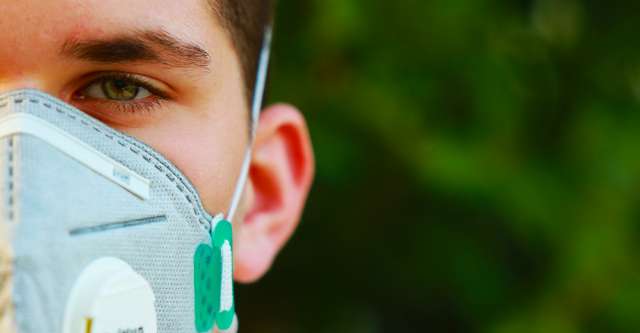Roosevelt said that it was his “…firm belief that the only thing we have to fear is…fear itself” and we, as Americans, cheered and agreed, then memorialized the quote in our collective psyche. Years have passed, and generations have been born, the last of some previous generations have left this world. Those of us left would do well to remember the rest of Roosevelt’s famous quote— the very essence of this fear that he instructed us to fear. It is a fear that is “nameless, unreasoning,” producing “unjustified terror which paralyzes needed efforts to convert retreat into advance.”
While studies are coming out that masks do stop Coronavirus (none of which are Randomized Controlled Trials, or RCT), masks are becoming a pacifier for nervous and fearful people because, frankly, studies are ambivalent at best about the effectiveness of masks. People want to believe that hydroxychloroquine helps too, and even though studies don’t prove that either masks or hydroxychloroquine work, people are quieted by their belief that they can.
But what are actual RCT studies showing?
Universal Masking Is Not The Answer
There is more to the spread of this virus than just covering our mouths. Everywhere we go, we touch. We touch a lot of things, and others touch the things we touch, and we touch the things they touch. Then we touch our mask, our eyes, yes, even our mouth too.
A mask will not protect providers caring for a patient with active Covid-19 if it’s not accompanied by meticulous hand hygiene, eye protection, gloves, and a gown.
Are the people advocating for masks like the proverbial camel’s nose in the tent; are they going to escalate until we are all walking around in space suits and carrying our oxygen in tanks? Again, these studies are with people trained in the health care field, and they are showing no “significant difference in the incidence of laboratory-confirmed influenza,” according to the Journal of American Medical Association (JAMA).
None of the studies established a conclusive relationship between mask/respirator use and protection against influenza infection [2]
To put it another way, these studies are randomized; they are conducted with oversight by investigators who are blind to the source of data until the study is finished. The “Gold Standard” of medical studies that we have all heard about for the last seven months.
These two studies are in a controlled environment—specifically, a controlled medical environment where the participants were trained, healthcare staff.
We Don’t Know How To Use Masks
The general populace at large doesn’t practice the hygiene necessary for masks to be effective. Every time you put your mask on, touch your mask (or any part of your face, body, anything significant) you are supposed to “wash your hands with soap and water for at least 20 seconds” according to the JAMA website [3]
Already the New York Times has felt the need to publish an article instructing people not to wear them on their chins or on their mouth only, or to chew while wearing them. This does not bode well. [4]
Just look around and watch your nervous fellow Americans, bite their masks, chew food while wearing them (taking them down and putting them up after every bite), adjust them, wear them around their neck, stuff them into pockets and purses and pull them out and cover their faces and then touch every product in stores while shopping.
Keeping Your Distance & Good Hygiene Are The Answer
A major problem with masks is that they become a pacifier to wearers who then lean closer to hear other people wearing masks, and overall think they are invincible while wearing their masks. JAMA says, “social distancing and good hand hygiene are the most important methods to prevent virus transmission.” People generally forget that.
…social distancing and good hand hygiene are the most important methods to prevent virus transmission
We need to remember that the scientific community is basically against wearing masks. The CDC itself and many other Health Organizations before this pandemic recommended against wearing of masks by healthy individuals “because air still can go around the edges of the not-so-tight seal of surgical masks, therefore they do not provide adequate protection.” So what changed?
Since the first days of the pandemic, Fauci, Birx, the CDC, and the WHO have been confusing the public as they flipped, flopped, and contradicted each other on the community wearing of medical masks [6]
The so-called experts are conflicted because political pressure and fear are driving what should be a straightforward scientific experiment. Masks work, or they don’t. Conversely, if there is ambiguity concerning the issue, let each individual decide.
Regarding RCT studies, very few have been conducted, and of those that are considered the best, none have been done with coronavirus—only influenza. Masks don’t protect from getting sick even when you know how to use them and are in a controlled environment. They may also pose serious health risks to the wearer [7]
If a policy is driven by science, then the policy implemented should be a non-policy regarding CoVID-19 based on the science at hand. If they are driven by fear, what about the people who will suffer health issues because of mandatory mask-wearing rules, mandates, or laws?
Policymakers and businesses who are fearful of legal entanglements would do well to consider that there will be another side who will have standing if they pass laws or mandates no matter which side they come down on, masks or freedom.
Notes:
- ^Klompas, M., Morris, C. A., Sinclair, J., Pearson, M., & Shenoy, E. S. (2020). Universal Masking in Hospitals in the Covid-19 Era. N. Engl. J. Med., 382(21), e63. doi: 10.1056/NEJMp2006372 (go back ↩)
- ^Bin-Reza, F., Chavarrias, V. L., Nicoll, A., & Chamberland, M. E. (2012). The use of masks and respirators to prevent transmission of influenza: a systematic review of the scientific evidence. Influenza and Other Respiratory Viruses, 6(4), 257–267. doi: 10.1111/j.1750-2659.2011.00307.x (go back ↩)
- ^https://jamanetwork.com/journals/jama/fullarticle/2764955 (go back ↩)
- ^Baynes, M. (2020). Jeremy Vine perfectly explains why you should NOT wear a face mask to protect yourself. Express.co. Retrieved from https://www.express.co.uk/news/uk/1270999/Jeremy-Vine-coronavirus-mask-why-not-to-wear-mask-twitter-COVID-19-protection (go back ↩)
- ^Desai, A. N., & Aronoff, D. M. (2020). Masks and Coronavirus Disease 2019 (COVID-19). JAMA, 323(20), 2103–2103. doi: 10.1001/jama.2020.6437 (go back ↩)
- ^Physician and Medical Journal Editor: Healthy People Should Not Wear Face Masks. (2020, July 04). Retrieved from https://vaccineimpact.com/2020/physician-and-medical-journal-editor-healthy-people-should-not-wear-face-masks (go back ↩)
- ^Author, A. (2020, August 15). Blaylock: Face Masks Pose Serious Risks To The Healthy. Retrieved from https://www.technocracy.news/blaylock-face-masks-pose-serious-risks-to-the-healthy/?fbclid=IwAR1ukQjaRQ1kjKDMjvPFqo5UgtR9W650QUGvEmtpyJsBIRN4tyIFONDZlFk (go back ↩)

